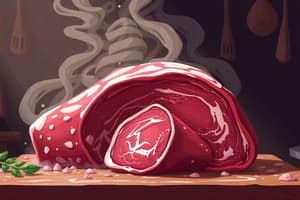Podcast
Questions and Answers
What is the primary purpose of the bone structure during the fabrication process?
What is the primary purpose of the bone structure during the fabrication process?
- To determine the sale price of the cuts
- To indicate the type of meat cooked
- To increase the weight of the carcass
- To guide the cutting and assess tenderness (correct)
Which wholesale cut is included in the hindquarter of beef?
Which wholesale cut is included in the hindquarter of beef?
- Round (correct)
- Plate
- Brisket
- Chuck
Which of the following is a characteristic of the porterhouse steak?
Which of the following is a characteristic of the porterhouse steak?
- Features a T-shaped bone with two tender muscles (correct)
- Has a circular bone structure
- Contains only one tender muscle
- Is known for its toughness
What is the chilling requirement for carcass preparation of beef or carabeef?
What is the chilling requirement for carcass preparation of beef or carabeef?
Which retail cut from the hindquarter is known for being the most tender?
Which retail cut from the hindquarter is known for being the most tender?
Which category of pork cuts includes pig's feet and tail?
Which category of pork cuts includes pig's feet and tail?
What distinguishes a T-bone steak from a porterhouse steak?
What distinguishes a T-bone steak from a porterhouse steak?
Which of the following is NOT a wholesale cut of pork?
Which of the following is NOT a wholesale cut of pork?
Flashcards are hidden until you start studying
Study Notes
Fabrication Overview
- Fabrication refers to cutting carcasses into wholesale and retail cuts.
Objectives
- Understand principles behind fabrication.
- Identify and list wholesale cuts.
- Recognize retail cuts derived from wholesale cuts.
Role of Bone Structure
- Acts as a guide for cutting carcasses.
- Indicates cut tenderness:
- Cuts with thoracic/lumbar bones are tender.
- Cuts from tibia, radius, and ulna are tougher.
- Cuts with scapula, humerus, and femur have medium tenderness.
- Assists in cut identification and age determination of the animal.
General Fabrication Procedures
- Chill carcasses at 2°C:
- 48 hours for carabeef and beef.
- 24 hours for pork.
- Cut pork carcass at 16°C.
Wholesale Cuts of Beef/Carabeef
- Front Quarter includes:
- Ribs, plate/short plate, brisket, foreshank, chuck.
- Hindquarter includes:
- Flank/navel, round, loin.
Specific Cuts
- Porterhouse Steak:
- Contains T-shaped bone.
- Features tenderloin and sirloin muscles.
- Most expensive cut; yields six slices per animal.
- T-Bone Steak:
- Similar to porterhouse but with smaller tenderloin.
- Club Steak:
- Last two one-inch slices of loin, lacks tenderloin muscle.
Retail Cuts from Hindquarter
- Round features various cuts:
- Rump roast, sirloin tip (boneless and easily formed), medium tender round steak, tough heel of round, soup bones.
Pork Cuts Classification
- Divided into three categories:
- Lean Cuts: Ham, loin, shoulder.
- Primal Cuts: Ham, loin, belly, shoulder.
- Miscellaneous Cuts: Pig’s feet, tail, fat/lean trimmings, neckbones, spare ribs.
Wholesale and Retail Cuts of Pork
- Shoulder/Batuk:
- Includes shoulder butt/Boston butt (bladebone), picnic (contains shank), neckbones, clear plate (lard), and jowl.
- Ham/Pige:
- Features trimmed ham, ham shank and butt, and center slice.
- Loin/Lomo:
- Cuts include pork chop (kostillas), center loin, loin end, and blade end.
- Belly/Side/Liempo: Further details not specified.
Studying That Suits You
Use AI to generate personalized quizzes and flashcards to suit your learning preferences.




